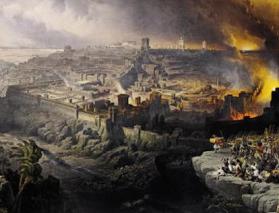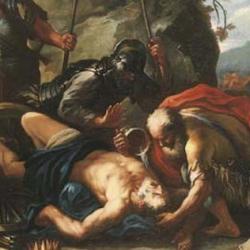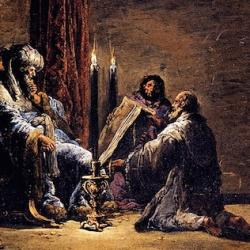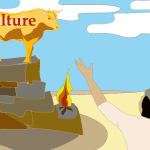1 Chronicles 18–20 brings together David’s conquests into a neatly packaged unit. (In Samuel, the same wars are scattered over several chapters.) By the end of chapter 20, David has established control over greater Israel, the ideal kingdom promised to Abraham (Genesis 15), stretching from the Euphrates (18:4) to the brook of Egypt (18:12–13). Though the bulk of these chapters is devoted to describing David’s battles, the structural center sketches David’s administration of Israel. Domestic justice is the central aim of David’s war-making.
The chapters follow a geographic pattern. David conquers Philistia, Moab, Ammon/Aram, Edom. Philistia is toward the Mediterranean coast, to the west of Israel; Moab is just to the east of the Jordan; David fights Hadadezer in Hamath in the far north, and Edom is south, toward the border of Egypt. David’s conquests move west-east, north-south.
There’s at least a four-corner theme there, David conquering to the corners of the land, a type of a future universal Davidic king. One wonders if something else is going on too. The Old Testament takes its orientation primarily from Israel’s sanctuaries, built on an east-west axis, the doorway to the east and the inner sanctuary to the west. Key temple furnishings are at each point of the compass: The bronze altar is east, the ark to the far west, the menorah to the south, and the table of showbread on the north.
James Jordan has argued that orientation is also linked to the faces of the cherubim. Working from Ezekiel’s vision of the merkabah, Yahweh’s chariot, he sketches this arrangement: The lion is on the west facing east; the bull east facing west; the eagle is south facing north; the man to the north facing south. To these, he adds another overlay: The lion is royal (“lion of Judah”); the ox is priestly (sacrificial); the eagle is prophetic; and the man unites all three.
When we put these three sets together, we get this picture:
|
Direction |
Cherub Face |
Sanctuary Furnishing |
“Office” |
|
West |
Lion (facing east) |
Ark-Throne |
King |
|
East |
Calf (facing west) |
Bronze altar |
Priest |
|
South |
Eagle (facing north) |
Menorah |
Prophet |
|
North |
Man (facing south) |
Table |
King, Priest, Prophet |
When we turn the key and put this system in motion, interesting things happen. The royal lion is enthroned to the west, but faces east; royal movement is from throne to altar, toward sacrifice; the enthroned lion is also the self-sacrificing king. The priestly calf or ox at the altar faces the ark-throne on the west; sacrificed on the altar, he moves toward enthronement, bringing tribute to the king. King and priest are mutually defining: A king’s rule is fulfilled in priestly self-sacrifice; a priest’s altar work aims at enthronement. (Take a moment to spin some Christological allegories. . . .)
The prophetic eagle shines the light of the menorah; like the lampstand, the prophet-eagle “watches” over the twelve loaves of Israel, burning with the seven eyes of the Spirit. As priest, king, and prophet together, the man is a baker and bread-server.
Now, what might this have to do with David’s conquests? David begins with a westward conquest. That is the position of the ark-throne and the lion. He establishes his royal dominion over Gath, setting up his throne toward the sunset. Then he moves east to Moab, to the ox and the altar; fittingly, the eastward Moabites are the first to bring tribute, a “bovine” sacrifice to the lion of Judah. After Abishai conquers Edom in the south, David sets up garrisons (18:13), lamps and watchers over the southern territory.
Overall, David’s movement is from throne-lion to ox-altar, then from table-man to lampstand-eagle. Lion, ox, man, eagle. That is, interestingly, the same order as the cherub faces in Revelation 4. It is not, however, the movement of Israel’s history generally, which moves from priest to king to prophet, finally coming to a climax in the man Jesus. Perhaps the order lion-ox-man-eagle is an order of conquest, while the arrangement ox-lion-eagle-man is a liturgical order.
Stepping back, we can draw this inference: David He established his throne; conquers peoples who pay tribute; sets up watch tower garrisons; brings the treasures of the conquered lands to the center, to the sanctuary. David’s four-cornered kingdom sets up a “sanctuary” land that replicates on a macro scale the microcosm of Yahweh’s house.















